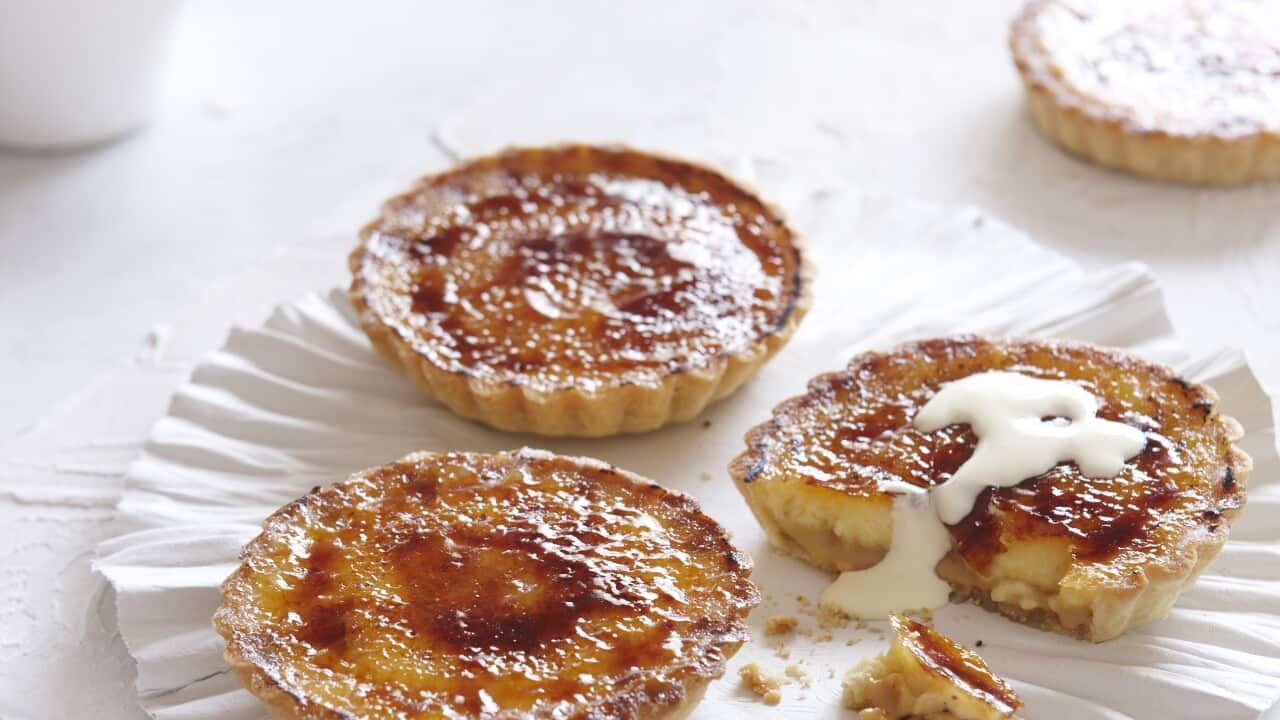makes
6
prep
20 minutes
cook
45 minutes
difficulty
Mid
makes
6
serves
preparation
20
minutes
cooking
45
minutes
difficulty
Mid
level
Ingredients
- 2 cups plain flour
- ⅓ cup almond meal
- 1 cup caster sugar
- 150 g butter, diced
- ⅓ cup iced water
- 1 egg
- 2 egg yolks
- 1 vanilla bean, split, seeds scraped
- 200 ml cream
- ½ cup
Chilling time 1 hour
Instructions
To make the pastry, combine the flour, almond meal, ¼ cup caster sugar and butter in the bowl of a large food processor. Process until it resembles breadcrumbs. Add the iced water through the feeder tube and keep processing until the pastry comes together in a ball.
Remove from the processor, shape into a log approximately 7 cm in diameter and wrap in plastic. Chill in the fridge for 30 minutes.
Remove from the fridge and, one at a time, slice off pieces of pastry, approximately 1½ cm thick. Roll out each disc of pastry (you should have six) between sheets of baking paper to approximately 3 mm thick. If the pastry is sticking to the paper sprinkle lightly with flour. Line six 10 cm tartlet pans with the pastry and place onto a tray. Refrigerate for 30 minutes.
Preheat oven to 180°C (360°F). Once the pastries have been chilled, prick the base of each one and line with foil. Fill with pie weights or rice and bake for 10 minutes. Remove from the oven and remove the foil and weights. Whisk the egg with 1 tablespoon of water, to make egg wash. Brush the tartlet cases with the egg wash and return to the oven for another 10 minutes until light golden in colour. Reduce the oven to 160°C (320°F).
To make the custard, combine ¼ cup of remaining caster sugar, egg yolks, vanilla seeds and cream in a jug, and whisk until sugar dissolves.
Spread 1 tablespoon of dulce de leche in each tartlet case and fill each one with the custard. Bake for 20 minutes or until the custard is set.
Allow the tartlets to cool then remove from tartlet pans. Sprinkle each tartlet with 2 teaspoons of remaining caster sugar and brûlée the top. Sprinkle with another 2 teaspoons of caster sugar and brûlée again. By brûléeing in two layers you get a thicker and crisper top without the sugar burning. Allow the sugar to set then serve.
the food dept. fact
• This recipe makes sufficient pastry to prepare this recipe a second time. If you are going to make pastry, why not pop the remaining pastry in the freezer for up to 3 months and make another batch of these beautiful tartlets? Or there is enough to line a 35 cm x 11 cm flan tin and you can make a variation on our delicious .
• This recipe makes sufficient pastry to prepare this recipe a second time. If you are going to make pastry, why not pop the remaining pastry in the freezer for up to 3 months and make another batch of these beautiful tartlets? Or there is enough to line a 35 cm x 11 cm flan tin and you can make a variation on our delicious .
Photography by Petrina Tinslay, styling by David Morgan and art direction by Anne Marie Cummins.
Cook's Notes
Oven temperatures are for conventional; if using fan-forced (convection), reduce the temperature by 20˚C. | We use Australian tablespoons and cups: 1 teaspoon equals 5 ml; 1 tablespoon equals 20 ml; 1 cup equals 250 ml. | All herbs are fresh (unless specified) and cups are lightly packed. | All vegetables are medium size and peeled, unless specified. | All eggs are 55-60 g, unless specified.

